Succulents have become more popular, and it is no wonder why. These little plants come in fun shapes and colors that go well with modern decor. Growing succulents indoors can be tricky, but that does mean that you should not grow them.
In general, the key to successfully growing succulents indoors is making sure your plants are exposed to enough sunlight and that you do not overwater them. To avoid overwatering, make sure you plant your succulent in a container with drainage holes until you are comfortable with watering them.
If you want you are new to growing succulents, do not worry! This article will give you the information you need to make your succulents look like the ones you see on Instagram.
Succulents That Grow Well Indoors
If you are looking to bring your succulent garden indoors, here are some types of succulents that you should consider.
Snake Plant

Dracaena trifasciatas, also known as snake plants, are becoming more and more popular. And it is easy to see why. These plants go well with modern-looking decor and are easy to grow indoors.
The snake plant is native to the tropical and subtropical regions of West Africa.
These plants can be neglected for weeks at a time and still look fresh. In addition, they can survive in low light and tend to have few pest problems. Research has shown that snake plants help keep the air inside your home clean.
According to the American Society for the Prevention of Cruelty to Animals (ASPCA), the snake plant is toxic to cats and dogs. Chewing on the leaves of a snake plant can cause diarrhea and vomiting.
Aloe Vera
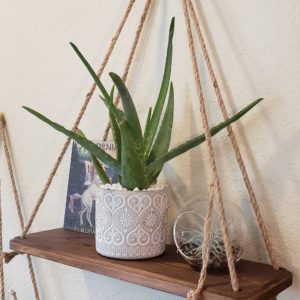
Aloe vera is a great plant to grow indoors because it is easy to care for and is an attractive succulent that can live for several years. In addition, the juice of aloe vera leaves can be used to ease the pain from sunburns.
Rotate your aloe vera plant every two to three months to ensure the plant is receiving light evenly. This will prevent your aloe vera plant from leaning toward the light source.
Alternatively, you can convert your aloe vera plant to semi-hydroponics (semi-hydro). This is a technique that involves growing your plants in a soil-less medium. The video below describes this process.
Jade Plant

Jade plants, also referred to as money plants or dollar plants, are probably the most popular succulent in the Crassula family. With proper care, these plants may even produce mildly fragrant flowers in late winter. These succulents make good bonsai trees.
If jade plants are not exposed to enough light, they can become leggy meaning that the plant looks like it is stretched. Succulents start to stretch or become legging when they are “reaching” for light.
Burro’s Tail

Burro’s tail (Sedum morganianum) is a species of succulent that produces long, trailing stems. As a result, they look really stunning in hanging baskets.
These succulents produce tiny flowers seasonally. The flowers will be red, white, or yellow depending on the cultivar.
Unfortunately, these succulents drop leaves easily. Every time you pick up the plant or water it, some leaves may tall off. For this reason, it is best to avoid repotting the plant. Fortunately, burro’s tail can be easily propagated from leaves.
Zebra Haworthia
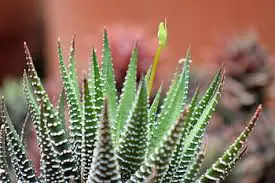
Another common indoor succulent plant is the zebra haworthia which is also known as the zebra cactus even though it is not actually a cactus. These plants have white stripes on the outside of their dark leaves. One of the reasons this succulent is so popular is that the stripes make zebra haworthia make this plant look great in fun, colorful pots.
Another reason that the zebra haworthia is popular is that it is a hardy plant that minimum care requirements. The zebra haworthia can go for weeks without water. They only need to be water once a week if you are growing indoors. During the wintertime, allow the soil to completely dry out before watering.
Finally, zebra haworthia is not toxic to cats or dogs!
Echeveria
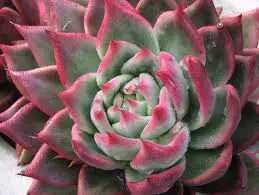
Echeveria is a large genus of rose-shaped succulents in the Crassulaceae family. They come in a wide variety of colors. Most species grow to be a few inches across.
It is typically easier to propagate Echeveria from leaf cuttings rather than stem cuttings. Simply place lead in a dish that contains some well-draining soil. Then cover the dish until the leaf sprouts.
Make sure you remove the dead leaves from the bottom of the plant. These dead leaves attract pests like mealy bugs.
Fishhook Senecio
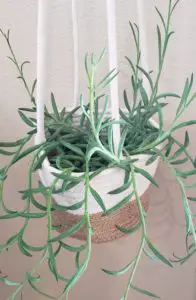
Senecio radicans, which are also known as Fishhook Senecio and string of bananas, are trailing succulents that grow very quickly. The small, pointed leaves of Fishhook Senecio grow in a single file along the cascading stems. They produce tiny flowers during the fall and winter.
These succulents should be placed in an area with bright sunlight. Fishhook Senecio will become leggy or stretched out if they do not receive enough light.
Fishhook Senecio is considered toxic, so be careful if you are growing these around children or pets as the shape of the leaves can be inviting.
String of Pearls
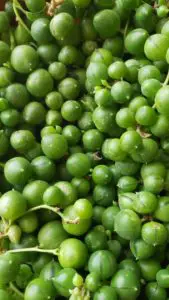
Senecio rowleyanus, which is commonly known as string of pearls, is a flowering plant that is a member of the daisy family Asteraceae. These gorgeous, cascading succulents look stunning in a hanging basket and add a little flair to any home decor.
In addition to their stunning foliage, string of pearls produce small white flowers that smell like cinnamon. To encourage the growth of these flowers, cut back on watering during the winter months and move them to a slightly cooler area (60°F).
String of pearls plants are toxic to cats, dogs, and humans if ingested.
Golden Sedum

Sedum is a large genus of flowering succulents within the Crassulaceae family. It is comprised of nearly 600 species of succulents with varying heights, colors, and shapes
One of my favorite succulents is the golden sedum (Sedum kamtschaticum) because its colors are very striking. They grow very quickly and produce tiny, yellow flowers. Golden sedums are a low-growing succulent that has many rosettes on each stem.
Like other succulents belonging to the Sedum genus, golden sedums will lose some of their color when they are not exposed to enough light. If the leaves of your golden sedum start to fade to green, place your plant in a sunnier location.
Gollum Jade
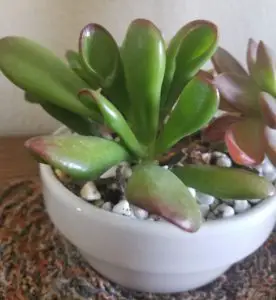
Carassula ovata ‘Gollum,’ which is also known as Gollum jade or finger jade, is a plant with tubular green leaves with red tips. As you may have guessed, these plants are named for the character in JRR Tolkein’s Lord of the Rings books. These plants will produce little pink flowers during late fall and early winter, and they can be grown as bonsai trees.
Gollum jade is toxic to dogs and cats and can cause vomiting. In addition, these plants are mildly toxic to humans. If ingested, it can cause diarrhea and vomiting. For these reasons, keep Gollum jade plants out of the reach of children and pets.
Ox Tongue
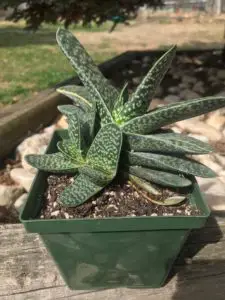
Gasteria verrucosa, which is commonly known as ox tongue or cow’s tongue is named for the sac-like shape of its flowers which look like a stomach.
The genus Gasteria is native to South Africa. In the wild, thee succulents grow in places that are lightly shaded with good drainage. As a result, they have adapted to low-light conditions. Place your ox tongue in a location that receives bright indirect light. Many indoor gardeners find that ox tongue succulents do well in cool rooms with limited sunlight.
If you start to see your ox tongue turn white or yellow, that is an indication that they are getting too much sun.
Lithops

Lithops are also known as living stones. They have become very popular due to their unusual appearance and because they require very little maintenance.
These weird little succulents are native to the dry regions of southern Africa. In the wild, they blend into their natural surroundings. This prevents grazing animals from eating them in order to extract the moisture from the plants.
Plant your lithops in a well-draining soil that contains very little organic matter. My lithops have been growing in a cactus soil mix for about two years and have been thriving. However, some people successfully grow their lithops in 100% gravel.
Thanksgiving Cactus
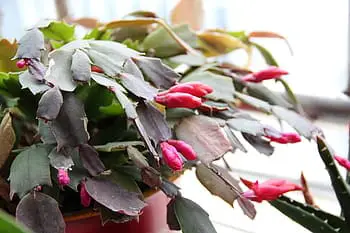
You may be surprised to see Thanksgiving cactus on this list rather than Christmas cactus. This is because stores typically sell Thanksgiving cacti as Christmas cacti. Every “Christmas cactus” I saw last holiday season was actually a Thanksgiving cactus.
To get your Thanksgiving cactus from last year to bloom on time, you will need to begin manipulating temperature and light exposure during mid-September. It will need to be exposed 12-14 hours of darkness and cool nighttime temperatures (60°F – 65°F). When you see buds, your plant can put the plant back in normal lighting.
These types of cacti can live a very long time (over 20 years) with proper care.
Soil For Indoor Succulents
The best potting soil for succulents is a well-draining soil because succulents are sensitive to overwatering. You can purchase a potting soil mix made for cacti and succulents at your local gardening center or at a big box store.
However, it is often cheaper to mix your own soil. Not only is mixing your own soil cheaper, but it is also easy. You can also control what is in your soil mix. An ideal soil mix for succulents consists of all-purpose potting soil, coarse sand, and perlite/pumice. You can find these ingredients at any major gardening center or big box store. The recipe is as follows:
- 3 parts potting soil
- 2 parts coarse sand
- 1 part perlite or pumice
It is important to use a light, porous potting soil as the base of your succulent mix. Do not purchase potting soil that contains vermiculite or other substances that will retain water.
You can also use turface or poultry grit in place of sand. Poultry grit is made of mostly crushed stone with additives. It helps birds digest their food. Turface contains high fired calcined clay. It contains small pockets of air that promote good drainage and strong root growth. Turface will change color when watered, so you will know whether your plants need to be watered.
Perlite vs Pumice
Both pumice and perlite promote good drainage and increase the amount of air available to plant roots. Both products are chemically inert and do not provide any nutrition to the plants. This is important because poor soil aeration can cause fungal disease and root rot.
Perlite is a lightweight soil additive made of volcanic rock. Unlike pumice, perlite is treated with heat which makes it sterile. Another advantage of using perlite is that it costs less than pumice.
Pumice is a light-colored volcanic rock and is commonly used for its abrasive properties in various commercial products. An advantage of using pumice is that it tends to look a little nicer in pots. However, pumice tends to be heavier than perlite and can weigh pots down.
Containers For Indoor Succulents
Picking out pots and containers to go with your succulents is a really enjoyable process. However, aesthetics is not the only thing you should consider when picking out a pot for your succulents.
Drainage Hole
When you first start growing succulents, make sure you are using pots with a drainage hole. Using a pot without a drainage hole significantly increases the chances of overwatering your plants. As you become more comfortable growing succulents and their watering requirements, you can start using pots without a drainage hole.
If you do find a ceramic or glass pot without a drainage hole, consider adding drainage holes using a diamond tip drill bit.
Material
Material is another thing to consider when picking out the perfect pot for your succulent. The table below lists the pros and cons of various pot materials.
| Material | Pros | Cons |
|---|---|---|
| Glazed Ceramic | Aesthetically pleasing and comes in a variety of colors and textures. | Glazed ceramic pots do not dry out as quickly as unglazed pots. This can restrict air movement from the sides of the pot. |
| Terra Cotta | Inexpensive and a breathable material | Terra cotta pots tend to be very heavy even before adding soil. |
| Concrete | Durable and great insulation to prevent temperature fluctuations. Breathable material. | Concrete can be quite heavy and a bit fragile. |
| Wood (Driftwood Planters) | Beautiful material | May rot quickly due to direct contact with water and bright light. |
| Plastic | Lightweight material and comes in a variety of colors. | Not breathable, but this should not be an issue if you are using well-draining soils. |
| Metal | Copper and brass are very trendy materials. | Metals can rust which is not good for your succulents. |
| Glass | Great for terrariums. | Lack of drainage holes, not as breathable as other materials, and breaks easily. |
If you are having trouble picking out the right material for your succulent, I recommend a concrete pot or a white, ceramic pot. These materials seem to work well with many types.
Size of Pot
Finally, it is important to select a pot that is the correct size. Many professional gardeners recommend using a container that is 10% larger (in diameter) than your succulent. This gives your succulent room to grow without running the risk of using a pot that retains too much moisture.
It is also important to make sure that your pot is of the appropriate length. The ideal succulent pot should be about 10% longer than the plant itself. This will ensure that there is enough room for healthy root growth.
If you are planting multiple succulents within one pot, make sure you give each succulent a little bit of room. Ideally, you will want to give each succulent 0.5″ to 1″ of room to allow them to spread out.
Lighting For Indoor Succulents
When you grow succulents indoors, it can be hard to make sure they get enough sunlight, especially during the winter. That doesn’t mean you cannot have indoor succulents. Luckily, you can use grow lights to ensure that your succulents get enough light.
Succulents that do not get enough light, they start to stretch out and lose their compact shape. This is fairly common during the wintertime. In addition, they can lose their bright colors.
Grow Lights For Indoor Succulents
If you cannot put your succulent near a sunny window, you can try using artificial lights. You might also want to consider using a grow light during the wintertime if the colors of your plant start to fade or if the plant becomes leggy.
The best way to describe the appearance of growth lights is by stating the color temperature which describes the warmth or coolness of a light source. Color temperature is typically expressed in kelvins (K). Succulents grow well under full-spectrum lights that mimic natural sunlight. The optimal color temperature for succulents is over 5,000 K. For stimulating succulent growth, the best color temperature is 6,500 K. If you want your succulent to bloom, it is better to use a grow light with a color temperature of 3,000 K.
The most common grow lights used by succulent growers are T5 and T8 fluorescent lights. The T5 grow lights are generally considered to be better than the T8 grow lights. However, T8 grow lights are more affordable and will still work well.
The most significant difference between T5 light bulbs and T8 light bulbs is the size of the bulb. T5 light bulbs are smaller than T8 bulbs, but they are capable of producing more light in a smaller area. A T5 bulb will produce around 5,000 lumens with 54 watts of power. In contrast, a T8 bulb will produce about 3,000 lumens with 32 watts per bulb. In other words, more T8 light bulbs are required to produce the same light as fewer T5 bulbs.
Light Emitting Diode (LED) lights are also used to grow succulents indoors. Although they are more cost-effective, LED lights do not produce very intense light. This can cause your succulents to lose their vibrant color and turning reen. In addition, LED grow lights emit light that is not very pleasing to the eye.
The distance between your succulent and the grow light is also important. If your succulent is too close to the grow light, the heat from the grow lights could burn the leaves of your plant. However, if your plant is too far away from the grow light, the succulent may not get enough light.
In general, your succulent should be about 6-12 inches away from fluorescent grow light lights and 18-24 inches from LED grow lights.
Although succulents require only six hours of direct sunlight when growing outdoors, you should keep the grow light on your plants between 12 and 14 hours per day.
Watering Indoor Succulents
Succulents require less water than most houseplants. The best way to water succulents is to use the “soak and dry” method. Rather than giving your succulents little “sips” of water every couple of days, most succulents do better when you water them thoroughly and then allow the top 2 inches of soil to completely dry between waterings.
This technique works well because succulents have the ability to store extra water in their stems and leaves. This is one of the reasons they are so popular in arid and semi-arid regions such as parts of Arizona and California.
Most succulents need to be watered most frequently during the spring, which is when the plant is growing. During the winter, succulents’ water requirements decrease significantly as their access to light diminishes. Only water once the top few inches when the top few inches of soil completely dries out during the winter. This could be as infrequently as once every 5-6 weeks depending on the size of your container, the type of succulent, and your geographic location.
Overwatering Indoor Succulents
Although succulents tend to be hardy plants, they are sensitive to overwatering. It is better to underwater succulents than to overwater them. Symptoms of overwatering include puffy leaves or stems, wilting leaves, and a generally unhealthy appearance. Ironically, a succulent may look like it needs more water when it is suffering from overwatering.
If your succulent appears to be suffering from overwatering, there are a few things you can do. First, unpot the plant and check the roots. Remove all dead/unhealthy roots using sharp, sterilized scissors. Next, remove any leaves or stems that are mushy or rotten. Then put the healthy portion of the plant in a bright area with good air circulation. After a few days, re-pot your plant in fresh, well-draining soil.
If you are attempting to save an overwatered succulent, be patient. It may take a few weeks to see any results.
Fertilizing Indoor Succulents
Eventually, watering and uptake will deplete plant nutrients from the soil. Fertilizing helps to replace these nutrients. In addition, fertilizing your succulent will encourage it to grow faster. Proper fertilizing can also help your succulents keep their vibrant colors. However, succulents typically require less fertilizer than other houseplants.
Overfertilizing your succulent can cause your succulent to grow too quickly. This could result in a stretched out or leggy appearance. In addition, too much nitrogen fertilizer can cause root rot problems in succulents.
I recommend fertilizing indoor succulents only once per year. After fertilizing your succulents, take them outside for a little while so they can get more sunlight. It is also a good idea to water your succulents after you fertilize them.
You should fertilize during the spring or fall, just before your succulent’s growing season. Use the lists below to determine whether your succulent is a winter grower or a summer grower.
| Winter Growers | Summer Growers |
|---|---|
| Adromischus | Agave |
| Aeonium | Lithops |
| Crassula | Euphorbia |
| Anacampseros | Echeveria |
| Aloe | Sempervivum |
| Graptopetalum | |
| Gasteria | |
| Graptoveria | |
| Haworthia | |
| Kalanchoe | |
| Pachyveria | |
| Senecio | |
| Pachyphytum | |
| Sedeveria | |
| Sedum |
Types of Fertilizer
Using the right blend of fertilizer is important. Any type of fertilizer that you purchase will display information about the nutrients it contains. This is typically shown as the N-P-K ratio which is the percentage of nitrogen (N), phosphorus (P), and potassium (K).
Although there is no idea N-P-K ratio for succulents, it is important to find a balanced fertilizer with the right amount of micronutrients. A balanced fertilizer has approximately equal amounts of nitrogen, phosphorus, and potassium. Soluble fertilizers such as 8-8-8 and 10-10-10 are commonly used. Make sure to dilute these types of fertilizers to half strength.
There are also fertilizers that are specially made for succulents and cacti. These types of fertilizers typically have lower amounts of nitrogen.
Finally, there are also dry fertilizers available. These fertilizers are “slow-release” meaning some nutrients will be released over the course of several waterings. Dry fertilizers are good to use when planting or re-potting your succulent. Simply mix the dry fertilizer into the soil per the manufacturer’s instructions.
Ideal Temperature Range For Succulents
Succulents tend to do best when the temperature is between 60°F and 80°F. Therefore, the temperature is typically not a concern when growing succulents indoors. However, you should be aware of the temperature outdoors if you keep your succulent by a window. During the winter, it can get cold and drafty next to windows. If this is the case in your home, consider moving your succulents somewhere else during the winter and using grow lights.
If your home gets particularly cold at night or during the winter, I recommend using a heating mat to keep them warm.
In addition, it is important to make sure that you do not place your succulent next to a fireplace or furnace. High temperatures can also be hard on succulents.

